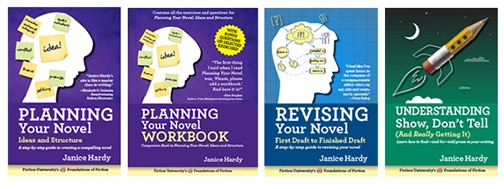7 Words That Often Tell, Not Show
By Janice Hardy, @Janice_Hardy
This week's Refresher Friday takes another look at one of my favorite subjects--show, don't tell!
I talk about character goals and motivation a lot, because they're the backbone of any story. But sometimes, they can be a red flag that you're telling and not showing.
Little words slip into our writing without us even noticing and lead us down the wrong path. So here are some words to keep an eye on, and things to look for during revisions.
To (Verb)
This is one of the biggest offenders.
Bob reached for the rifle to shoot the zombie.
To shoot implies motive, which is great, right? We want to show motive. But ah, that's the catch. We want to show motive, not tell it. And "to shoot" in this type of sentence is telling. We don't see Bob shoot the zombie, or even decide to soot it, we tell the reader that he plans to do it. Odds are the next line in this scene will be something shown.
Bob reached for the rifle to shoot the zombie. The barrel flashed and a deafening bang shook the windows.
Nice and shown there. But since we showed the rifle going off, did we really need the "to shoot" part? Nope.
Bob reached for the rifle. The barrel flashed and a deafening bang shook the windows.
It still reads a little clunky, because that sense of motive is gone. We get a taste of it since Bob reached for the rifle, and our first instinct was to say why (hence the "to shoot" part in the first draft), so let's add the motive back. But let's do it in a ways that shows, not tells.
Bob reached for the rifle and took aim at the zombie's head, right between its blood-shot eyes. The barrel flashed and a deafening bang shook the windows.
That's so much better, isn't it? Taking aim shows Bob's intention. And the internal "right between its blood-shot eyes" is Bob's judgment, tightening your POV and adding a sense of immediacy that should also heighten the tension of the scene.
When
Here's another word that can indicate told prose.
When Bob saw the zombie, he ran for the cabin. (or worse) Bob ran for the cabin when he saw the zombie.
This little teller not only keeps you distanced from your POV character, but in version two, you put the response before the stimulus, so readers see what Bob does before the know why he decided to do it. That's a good way to confuse your reader. "When" used in these ways is the author explaining why Bob acted instead of showing the reader Bob making that decision and then acting on it. The goal is to allow the reader to get the why by observing the what.
A zombie lurched toward him. "Braaaiiinss!"
Bob ran for the cabin.
As
As can be such a useful tool, but it can also muck things up, because it works a lot like "when" does.
Bob ran for the cabin as the zombie swung at his head.
On first glance, this looks perfectly fine, but look at the two actions closer. "As" implies these actions happen simultaneously. Bob does X as the zombie does Y. But the zombie swinging at Bob's head is what makes him run for the cabin. So Bob can't run at the same time the zombie is swinging, because he hasn't made the decision to run until the zombie swings. (One note here. If the zombie has been attacking before this and this swing is one in several swings, then it's plausible Bob anticipates it coming as can run as it swings)
(Here are more red flag words for telling)
In (Emotion)
This is another great red flag that you're telling how something is done rather than showing the outward signs of it. "In (emotion)" is another type of explanation.
The zombie burst through the window. Bob screamed in fear.
Not only is this redundant (screaming is usually caused by fear in this situation), it doesn't give any additional information or strengthen the verb, screamed.
The zombie burst through the window. Bob screamed, his knees buckling beneath him.
Knees buckling is a good "fear" indicator. Better still, it shows how the sudden appearance of a zombie affects Bob on a physical level.
(Here's more on describing emotions)
Could See
One of the easiest told clean ups are sentences where your narrator "could see something," and then goes on to tell us what he saw. "Noticed" can also trip you up this way, so be sure than when using noticed, it's for something that is eye catching. It's not a synonym for saw.
A twig snapped. Bob turned around. He could see a zombie lumbering toward the cabin.
If Bob is our narrator, then by definition, everything he describes is something he sees, hears, feels, smells, says, thinks, right? We don't have to be told he sees it if he tells us what it looks like. (And by the way, "could see/hear/smell/feel" can also be applied here)
A twig snapped. Bob turned around. A zombie lumbered toward the cabin.
The Sound of
The second cousin of the "could see" is the "sound of." It tells for all the same reasons.
The sound of a rifle shot echoed through the valley.
This one is particularly sneaky, because that sentence reads just fine. And sometimes, it is just fine. But telling something there's a sound of a rifle shot is still telling.
The crack of a rifle shot echoed through the valley.
One word change, doesn't this read stronger? Can't you hear that crack?
(Here's more on showing sound)
Realized
This one is the trickiest of them all, because many times, realized is the right word and it works as intended. But often, it's used to explain how a POV character came to a conclusion. It's that explanation that tells.
A door creaked, and Bob realized he'd forgotten to lock the back door.
This tells me what Bob realized. It doesn't show him realizing it.
A door creaked. Bob spun around, heart racing. Oh crap, the back door!
Triple Threats
The thing about these little tell words, is that they often gang up on you. They're descriptive because you as the author see so much more in them, so you don't always notice they aren't saying much. Then you realize you're explaining everything and there's no actual story going on.
Bob screamed in pain when the Zombie clawed his leg.
Do we feel Bob's pain here? No, we're told the cause of his screaming. But we also see the reason -- the zombie claw. And lookie there... a when! These two often go hand in hand. And worse still, a response before the stimulus. See how easy it is for these little buggers to gang up on you?
The zombie tore through his pants, sinking its broken fingernail deep into his calf. Bob screamed, burning pain shooting up his leg.
Isn't that a lot more exciting? Same idea, but now you have details and action that bring it to life.
Will hunting and editing these little words take time? You betcha. But in the end, you'll have a much better story that shows instead of tells. Better still, you'll train yourself to identify and catch these suckers before they muck up your story.
(Here's more on what you need to know about shown, don't tell)
"Don't tell" is a huge stick hanging over our heads, but sometimes, a little telling here and there is fine. Don't look at a list like this and think you have to eliminate every last one of them from your novel. Like everything else, whatever serves the story is what's best. If something jars the reader out of the narrative or makes them feel detached and disinterested, change it. If it doesn't do that and the reader stays hooked and immersed in the story, you're golden.
How often do you find these words in your manuscript?
Looking for tips on planning, writing, or revising your novel? Check out one of my books on writing: Planning Your Novel: Ideas and Structure, a self-guided workshop for planning or revising a novel, the companion Planning Your Novel Workbook, Revising Your Novel: First Draft to Finished Draft, your step-by-step guide to revising a novel, and the first book in my Skill Builders Series, Understanding Show Don't Tell (And Really Getting It).
 A long-time fantasy reader, Janice Hardy always wondered about the darker side of healing. For her fantasy trilogy The Healing Wars, she tapped into her own dark side to create a world where healing was dangerous, and those with the best intentions often made the worst choices. Her novels include The Shifter, Blue Fire, and Darkfall from Balzer+Bray/Harper Collins. The Shifter, was chosen for the 2014 list of "Ten Books All Young Georgians Should Read" from the Georgia Center for the Book. It was also shortlisted for the Waterstones Children's Book Prize, and The Truman Award in 2011.
A long-time fantasy reader, Janice Hardy always wondered about the darker side of healing. For her fantasy trilogy The Healing Wars, she tapped into her own dark side to create a world where healing was dangerous, and those with the best intentions often made the worst choices. Her novels include The Shifter, Blue Fire, and Darkfall from Balzer+Bray/Harper Collins. The Shifter, was chosen for the 2014 list of "Ten Books All Young Georgians Should Read" from the Georgia Center for the Book. It was also shortlisted for the Waterstones Children's Book Prize, and The Truman Award in 2011.
Janice is also the founder of Fiction University, a site dedicated to helping writers improve their craft. Her popular Foundations of Fiction series includes Planning Your Novel: Ideas and Structure, a self-guided workshop for planning or revising a novel, the companion Planning Your Novel Workbook, Revising Your Novel: First Draft to Finished Draft, your step-by-step guide to revising a novel, and the first book in her Skill Builders Series, Understanding Show Don't Tell (And Really Getting It).

